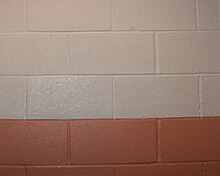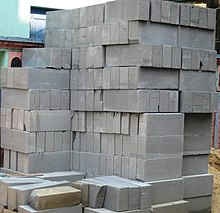How Do You Know Which Way Is the Top of a Cmu


An interior wall of painted CMUs


A building synthetic with physical masonry blocks
A concrete masonry unit (CMU) is a standard-size rectangular block used in building construction. CMUs are some of the about versatile building products available because of the broad multifariousness of appearances that can be achieved using them.[1]
Those that use cinders (wing ash or bottom ash) as an aggregate material are called cinder blocks in the United States, breeze blocks (breeze is a synonym of ash)[2] in the United kingdom of great britain and northern ireland, and hollow blocks in the Philippines. In New Zealand and Canada they are known as concrete blocks (a name mutual in the United states of america also). In New Zealand, they are likewise called construction blocks. In Australia, they are known every bit Besser blocks or Besser bricks, considering the Besser Visitor was a major supplier of machines that made concrete blocks. Dissidence blocks employ clinker equally aggregate.
In non-technical usage, the terms cinder cake and breeze block are oft generalized to encompass all of these varieties.
Composition [edit]
Concrete blocks are made from cast concrete (east.thou. Portland cement and amass, normally sand and fine gravel, for high-density blocks). Lower density blocks may use industrial wastes, such equally fly ash or bottom ash,[3] [4] equally an aggregate.[5] Recycled materials, such as mail service-consumer glass, slag cement, or recycled aggregate, are often used in the composition of the blocks.[6] Use of recycled materials within blocks can create dissimilar appearances in the block, such equally a terrazzo finish, and may help the finished structure earn LEED certification. Lightweight blocks can also exist produced using autoclaved aerated concrete; these are widely used for construction in Finland and like northern countries for the material'southward inherent thermal isolation characteristics, as are expanded clay aggregate blocks.
Sizes and structure [edit]
The use of blockwork allows structures to be built in the traditional masonry mode with layers (or courses) of staggered blocks. Physical blocks may be produced with hollow centers (cores) to reduce weight, improve insulation and provide an interconnected void into which concrete tin can be poured to solidify the unabridged wall after it is built. Blocks come in modular sizes, with the well-nigh popular typically referred to (past their thickness) as "four-inch", "6-inch", "8-inch", and "12-inch". In the US, CMU blocks are nominally 16 in (410 mm) long and 8 in (200 mm) wide. Their actual dimensions are iii⁄eight inch (9.5 mm) less than the nominal dimensions (to allow for 3⁄8 -inch mortar joints between blocks in whatsoever orientation).[7] In Ireland and the UK, blocks are commonly 440 mm × 215 mm × 100 mm (17.3 in × 8.5 in × three.9 in) excluding mortar joints. In Australia, New Zealand and Canada, blocks are unremarkably 390 mm × 190 mm × 190 mm (fifteen.4 in × vii.5 in × 7.v in) excluding mortar joints.
Block cores are typically tapered and then that their top surface (as laid) has a greater surface on which to spread a mortar bed and for easier treatment. Most CMUs have ii cores, only three- and iv-core units are also produced. A core also allows for the insertion of steel reinforcement to span courses in order to increase tensile strength. This is accomplished by grouting the voids of blocks containing rebar with physical. Thus reinforced, CMU walls are amend able to resist lateral forces such as wind load and seismic forces.[8] Cores may also be filled with expanded-polystyrene (EPS) block foam insulation, substantially increasing the R-value of the resulting wall to be in compliance with the U.s. national free energy code.[ix]
A diversity of specialized shapes be to allow special construction features. U-shaped blocks or knockout blocks with notches to permit the construction of bond beams or lintel assemblies, using horizontal reinforcing grouted into identify in the cavity. Blocks with a aqueduct on the end, known equally "jamb blocks", allow doors to be secured to wall assemblies. Blocks with grooved ends permit the construction of control joints, allowing a filler material to be anchored between the un-mortared block ends. Other features, such as radiused corners known equally "bullnoses" may be incorporated. A wide variety of decorative profiles also exist.[10]
CMUs may exist formulated with special aggregates to produce specific colors or textures for stop use. Special textures may be produced by splitting a ribbed or solid ii-block unit; such factory-produced units are chosen "split-rib" or "split-face" blocks.[11] Blocks may exist scored by grooves the width of a mortar joint to simulate different block modules. For example, an 8-by-16-inch (200 mm × 410 mm) cake may be scored in the middle to simulate 8-past-8-inch (200 mm × 200 mm) masonry, with the grooves filled with mortar and struck to lucifer the true joints.[12]
General data [edit]
Uses [edit]
Physical block, when congenital with integral steel reinforcement, is a very mutual building cloth for the load-bearing walls of buildings, in what is termed physical block structure (CBS) construction. I of the mutual foundation types for American suburban houses is the "crawl space foundation" which consists of a concrete cake wall around the perimeter on which dimensional lumber flooring joists are supported. Retaining walls, which also tin be constructed of concrete blocks, either using blocks designed to be ready dorsum each course and used with a sand base of operations and without mortar or reinforcing (gravity wall), or using blocks (typically an architectural style of cake or clad with a veneer such as brick) with a physical base, steel reinforcing and mortar (piling wall). Other very mutual, non-structural uses for concrete block walls (especially in American schools) are equally interior burn down-rated and extremely durable partition walls, and equally outside backup drape walls for zipper of building envelope systems (rigid cream insulation and an air/vapor barrier) and veneers (stucco, steel, brick, or dissever-face physical block).
Structural properties [edit]
Physical masonry walls may be ungrouted, partially grouted, or fully grouted, the latter two enhancing their structural strength. Additionally, steel reinforcement confined (rebar) can be used both vertically and horizontally inside a CMU wall to maximize its structural functioning. The cells in which the rebar is placed must be grouted for the bars to bond to the wall. For this reason, high seismic zones typically just allow fully grouted walls in their edifice codes. The American pattern code that guides design engineers in using CMU as a structural system is the Masonry Standards Joint Commission's Building Code Requirements & Specification for Masonry Structures (TMS 402/ACI 530/ASCE 5).[ commendation needed ]
The compressive forcefulness of concrete masonry units and masonry walls varies from approximately 3.four to 34.5 MPa (500–five,000 psi) based on the blazon of concrete used to manufacture the unit, stacking orientation, the blazon of mortar used to build the wall, it depends on whether it is a load bearing segmentation or non and other factors. [13] [14] [15] [16]
Come across also [edit]
- Concrete bricks
- Gypsum block
- Rusticated concrete block
- Wing ash brick
References [edit]
- ^ "Concrete Masonry". ncma.org. Archived from the original on 2019-02-13. Retrieved 2019-02-12 .
- ^ "breeze, n.3 ". breeze. The Oxford English Dictionary (2nd ed.). Oxford University Press. 1989. Archived from the original on May 24, 2011. Retrieved 2007-11-xxx .
- ^ "A new invention by two female engineers could exist the solution to Gaza's rebuilding bug - The Independent". 28 February 2018. Archived from the original on 28 February 2018. Retrieved twenty October 2018.
- ^ "Rebuilding Gaza: 'Green Block' could be the phoenix ascension from Gaza'southward ashes - Middle East Eye". 17 April 2017. Archived from the original on 17 April 2017. Retrieved 20 October 2018.
- ^ "Block Making Machine aggregate example". Web Editor.
- ^ "Masonry & LEED v4: Continuing Teaching from Echelon Masonry". www.echelonmasonry.com . Retrieved 2019-02-12 .
- ^ "Concrete Block (CMU) Sizes, Shapes, and Finishes". Archtoolbox.com.
- ^ Beall 1987, pp. 61–63.
- ^ "EPS Insulation | Geofoam, Styrofoam, EPS & Polystyrene | Universal Foam Products". universalconstructionfoam.com . Retrieved 2020-10-26 .
- ^ Beall 1987, pp. 66–68.
- ^ Beall 1987, pp. 68–70.
- ^ Ching, Francis D.K. (2012). A Visual Dictionary of Architecture (2nd ed.). John Wiley & Sons, Inc. p. 168. ISBN978-0-470-64885-eight.
- ^ "ASTM Specifications for physical masonry units".
- ^ "Compressive Strength of Masonry" (PDF). Portland Cement Organisation. Retrieved June 5, 2016.
- ^ "Comprehensive Strength of Hollow Concrete Blockwork" (PDF). Government of Canada. iv June 1986. Archived from the original (PDF) on 2012-09-16.
- ^ "Properties of Concrete Blocks — Strength".
Sources [edit]
- Beall, Christine (1987). Masonry Design and Detailing for Architects, Engineers and Builders. New York: McGraw-Loma. pp. 61–63. ISBN0-07-004223-3.
External links [edit]
- How Products Are Fabricated: Volume 3 Physical Block
- Concrete Masonry Association of California and Nevada
- National Concrete Masonry Association
- Mason Contractors Association of America
- Concrete Cake Association
- Masonry Institute of America
- "The History Behind Rock Confront Block"—Classic Rock Face up Block
Source: https://en.wikipedia.org/wiki/Concrete_masonry_unit
0 Response to "How Do You Know Which Way Is the Top of a Cmu"
Post a Comment